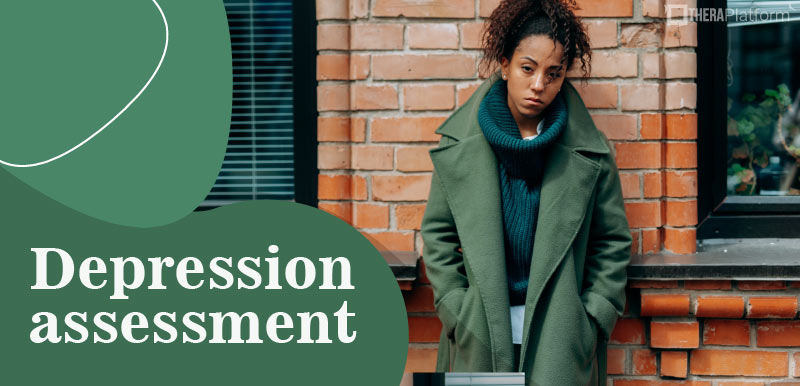DASS-21

DASS-21 or the Depression Anxiety Stress Scale 21 a widely utilized self-report questionnaire for evaluating the severity of depression, anxiety, and stress symptoms in individuals. Assessing emotional well-being is an important aspect of therapy, as emotional disturbances can significantly impact an individual's mental health and life satisfaction.
Summary
- DASS-21 is a reliable tool for measuring the severity of depression, anxiety, and stress symptoms in clients. Its brief format makes it ideal for both clinical and research settings. Download my free anxiety worksheets now.
- Therapists can use DASS-21 results to tailor treatment plans, identify emotional patterns, and guide therapy goals based on specific subscale scores.
- Administering and interpreting DASS-21 requires a structured process—including client education, accurate scoring, and collaborative discussion of results—to ensure its therapeutic value. Therapists can organize and manage this process by using an EHR like TheraPlatform.
- Targeted interventions based on scores include CBT, behavioral activation, mindfulness, relaxation training, exposure therapy, and stress management techniques for enhanced emotional well-being.
Streamline your practice with One EHR
- Scheduling
- Flexible notes
- Template library
- Billing & payments
- Insurance claims
- Client portal
- Telehealth
- E-fax

To effectively address these issues, reliable tools for measuring emotional states are essential. This blog will examine the background of the DASS-21, tips for administering, scoring and interpreting the DASS-21 and how to create treatment plans.
Brief overview of the Depression Anxiety Stress Scale 21 (DASS-21)
The DASS-21, developed by Peter Lovibond and Syd Lovibond, is a condensed version of the original DASS, offering a more efficient approach to emotional assessment. It has gained recognition in both clinical and research settings due to its robust psychometric properties. The scale serves as a valuable resource for clinicians and researchers seeking insights into the emotional well-being of their clients or study participants.
Development and purpose of the DASS-21
DASS-21 was designed to be used in clinical settings to aid therapists in evaluating the severity of emotional symptoms in patients and helping them tailor treatment plans accordingly. Additionally, it serves as a valuable tool for researchers studying emotional states, as it allows for efficient data collection across a range of emotional domains. The brevity of DASS-21 makes it especially convenient for both clinicians and researchers, without compromising its psychometric properties and reliability.
Overview of the three main subscales: Depression, anxiety and stress
DASS-21 consists of three primary subscales, each dedicated to measuring specific emotional states: depression, anxiety, and stress. These subscales allow for a detailed assessment of an individual's emotional well-being.
- The Depression subscale focuses on symptoms such as low mood, hopelessness, and lack of interest or pleasure in daily activities.
- The Anxiety subscale assesses symptoms related to excessive worry, restlessness, and the experience of tension.
- The Stress subscale evaluates emotional and physiological responses to stressors, including symptoms like nervousness and irritability.
By examining these subscales separately, DASS-21 provides a comprehensive picture of an individual's emotional state, aiding therapists and researchers in identifying the primary areas of concern.
Practice Management + EHR + Telehealth
Manage more in less time in your practice with TheraPlatform
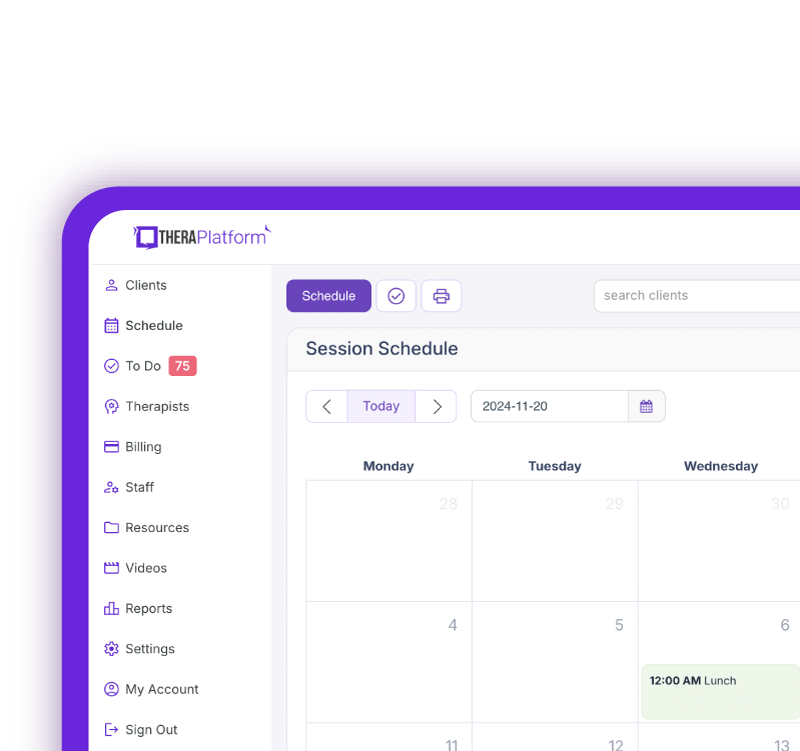
Steps for administering the DASS-21 scale to clients
Administering the Depression Anxiety Stress Scale 21 (DASS-21) requires a structured approach to ensure accurate results and meaningful insights into clients' emotional well-being.
Here are the essential steps for effectively administering the scale:
- Introduction and explanation: Begin by introducing the purpose of the assessment to the client. Explain that the DASS-21 is designed to measure the severity of their emotional symptoms, specifically focusing on depression, anxiety, and stress. Provide assurance of confidentiality and emphasize the importance of honest and candid responses.
- Clear instructions: Read the instructions provided with the DASS-21 carefully, ensuring you understand the scale's format and scoring process.
- Explain the response format: Clients are typically asked to rate the extent to which specific statements apply to them over the past week, using a Likert scale (e.g., 0 - Did not apply to me at all, 3 - Applied to me very much or most of the time).
- Self-administered or interview format: Depending on the client's comfort level, the DASS-21 can be self-administered, where the client completes the questionnaire independently, or administered as part of an interview. Choose the format that aligns best with the client's preferences and needs.
- Ensure a comfortable environment: Create a comfortable and private setting for the assessment to encourage open and honest responses. Be available to address any questions or concerns that may arise during the completion of the DASS-21.
- Timing: Instruct clients to complete the DASS-21 in a quiet and focused manner, taking their time to reflect on each item. Provide an estimate of how long the assessment is expected to take to manage client expectations.
- Review responses: Once the client has completed the DASS-21, review their responses to ensure they have answered all the questions. Offer a brief debriefing, emphasizing that the results will be used to tailor therapy strategies and interventions.
- Scoring and interpretation: Explain that their responses will be scored, and the results will be discussed in the next session. Reiterate the importance of honest and accurate responses, as this will contribute to a more effective therapeutic process.
Free Resources for Therapists
Click below and help yourself to peer-created resources:

Explanation of scoring methodology for each subscale
Scoring the DASS-21 involves summing the responses to the relevant items in each of the three subscales: Depression, Anxiety, and Stress. Each subscale comprises seven items, resulting in a possible score range of 0 to 21 for each subscale. Higher scores indicate a greater severity of symptoms in the respective emotional domain.
What does a DASS 21 score mean?
Interpreting DASS-21 scores involves assessing the client's emotional well-being relative to established norms and clinical cutoffs. It's important to note that DASS-21 scores do not provide a clinical diagnosis but offer valuable insights into the severity of emotional symptoms.
Interpretation considerations include:
- Normal range: Scores within the lower range are generally indicative of normal emotional well-being.
- Mild to moderate: Scores in the mid-range may suggest mild to moderate emotional distress and may warrant further attention and support.
- Severe: Scores in the higher range indicate severe emotional distress, and clients with such scores may require more intensive therapeutic interventions.
The interpretation should also consider the specific subscale(s) where elevated scores are observed, as this can guide treatment strategies and goals.
Identifying potential patterns and trends in clients' emotional states
Beyond individual subscale scores, therapists should analyze patterns and trends across the Depression, Anxiety, and Stress subscales. For example, a client with significantly higher scores in the Stress subscale compared to the other two may be experiencing situational stressors. Recognizing these patterns helps tailor therapy interventions and goals to address the client's unique emotional challenges effectively.
In summary, administering the DASS-21 with care and professionalism allows therapists to gain valuable insights into clients' emotional well-being. By explaining the scoring and interpretation process, therapists can use the assessment as a valuable tool to inform and enhance the therapeutic journey.
Collaborative discussion of assessment results with clients
Open and collaborative communication with clients about their DASS-21 assessment results is a crucial step in the therapeutic process. This discussion aims to create a safe space for clients to explore and understand their emotional well-being.
Key components of this discussion include:
Results presentation:
- Begin by presenting the DASS-21 scores, explaining the significance of each subscale (Depression, Anxiety, Stress).
- Emphasize that the assessment is a tool to enhance therapy, not a judgment of the client's character or worth.
- Exploration and validation: Encourage clients to share their thoughts and feelings about the assessment results. Validate their emotional responses, acknowledging that discussing emotions can be challenging. Explore the factors contributing to their emotional states and any recent life events that may have influenced their scores.
- Client Insight: Collaboratively analyze the assessment results to identify patterns or triggers that may be contributing to emotional distress. Invite clients to reflect on their emotional experiences, helping them gain insight into their thoughts and behaviors.
Using DASS-21 outcomes to inform treatment planning and goal-setting
DASS-21 assessment outcomes serve as valuable data points that can guide the development of an effective treatment plan.
Therapists can leverage these outcomes in several ways:
- Tailoring treatment goals: Based on the assessment results and collaborative discussion, establish specific and measurable treatment goals that address the client's emotional needs. Ensure that these goals are realistic and align with the client's expectations and desired outcomes.
- Intervention selection: Select therapeutic interventions and techniques that are well-suited to target the emotional states identified in the DASS-21 results. Adapt treatment modalities to address specific symptoms or triggers highlighted by the assessment.
- Progress monitoring: Use the DASS-21 as a tool for ongoing progress monitoring throughout therapy. Periodically re-administer the assessment to track changes in emotional well-being and adjust treatment strategies accordingly.
Addressing client reactions and emotions related to assessment scores
Clients may experience a range of emotions when confronted with their DASS-21 scores, including anxiety, sadness, or relief.
Therapists should be prepared to address and support a variety of emotions.
- Emotional validation: Acknowledge and validate the client's emotional reactions to the assessment results. Normalize the experience of mixed or intense emotions. Create an atmosphere of acceptance, emphasizing that therapy is a safe space to explore and address these emotions.
- Psychoeducation: Offer psychoeducation on the variability of emotional states and the potential for improvement through therapy. Share information about the effectiveness of evidence-based interventions in addressing depression, anxiety, and stress.
- Emotion regulation: Provide clients with practical strategies for managing their emotional reactions between therapy sessions. Encourage the development of emotion regulation skills to cope with distressing feelings.
Practice Management + EHR + Telehealth
Manage more in less time in your practice with TheraPlatform

Exploring therapeutic approaches for clients with high depression scores
When clients exhibit high depression scores on the DASS-21, it is essential to implement therapeutic interventions that specifically target depressive symptoms.
Some effective approaches include:
- Cognitive-Behavioral Therapy (CBT) helps clients identify and challenge negative thought patterns and beliefs contributing to depression.Encourage clients to reframe negative thoughts and develop more adaptive thinking styles.
- Behavioral Activation focuses on increasing clients' engagement in positive and rewarding activities, combatting the lethargy often associated with depression. Patients and therapists collaborate on creating a structured daily routine that includes enjoyable and meaningful activities.
- Mindfulness-based interventions practices can help clients cultivate present-moment awareness and self-compassion, reducing depressive symptoms. Guide clients through mindfulness exercises to manage overwhelming emotions and enhance emotional regulation.
Strategies for addressing anxiety-related concerns based on assessment results
For clients with elevated anxiety scores on the DASS-21, therapeutic strategies should target anxiety symptoms.
Consider the following approaches:
- Relaxation techniques: Teach clients relaxation techniques such as deep breathing, progressive muscle relaxation, or guided imagery to reduce physiological arousal associated with anxiety.
- Exposure therapy: Gradual exposure to anxiety-provoking situations can help clients desensitize and manage their anxiety. Develop a hierarchy of anxiety-inducing scenarios and work with clients to confront them in a controlled and supportive manner.
- Cognitive restructuring: Employ cognitive restructuring techniques to challenge irrational fears and anxiety-driven thoughts. Help clients replace catastrophic thinking with more realistic and balanced perspectives.
Techniques for managing stress and building emotional resilience
Clients with high stress scores on the DASS-21 may benefit from stress management and resilience-building techniques.
Here are some effective strategies:
- Teach stress reduction techniques such as progressive muscle relaxation, mindfulness meditation, and guided imagery to help clients manage stressors.
- Assist clients in developing effective time management and organizational skills to reduce stress associated with time constraints and responsibilities.
- Encourage clients to engage in activities that enhance emotional resilience, such as journaling, practicing gratitude, and seeking social support.
- Provide clients with information about stress, its physiological effects, and healthy coping strategies.
- Help clients identify and modify sources of chronic stress, when possible.
Tailoring interventions based on DASS-21 assessment results allows therapists to address clients' unique emotional needs effectively. By selecting evidence-based approaches and strategies that align with specific emotional states, therapists can guide clients toward improved emotional well-being and enhanced overall mental health.
Practice Management + EHR + Telehealth
Manage more in less time in your practice with TheraPlatform

Resources for therapists on the DASS and DASS-21
Readings and Research
For therapists seeking to deepen their understanding of the Depression Anxiety Stress Scale (DASS) and its shorter version, DASS-21, there are numerous readings and research materials available.
- The scale itself along with the ability to order the manuals is readily available from the University of New South Wales.
- Additionally, exploring academic journals and publications on psychological assessment and emotional well-being will provide valuable insights into the development, validity, and clinical applications of these scales. The original publication by the Lovibonds is a good place to start.
- Access to relevant literature can be found through academic databases such as PubMed or Google Scholar.
Workshops and training for therapists
Attending workshops and training programs focused on the DASS and DASS-21 can greatly enhance a therapist's ability to effectively administer and interpret these assessments. Organizations, universities, and professional associations often offer workshops and online courses covering various aspects of emotional assessment and its integration into therapeutic practice. Look for programs provided by renowned institutions or associations such as the American Psychological Association (APA) or the British Psychological Society (BPS) for comprehensive training opportunities.
Support networks and forums for therapists focused on emotional Health
Therapists seeking peer support and professional discussions around emotional health and the use of assessment tools like DASS-21 can benefit from joining support networks and online forums. Websites like Psychology Today or TherapyRoute provide directories of therapists, and many of them offer resources and forums for clinicians. Additionally, platforms like LinkedIn and specialized therapist communities on social media can be valuable sources for networking and sharing experiences related to emotional assessment and therapeutic techniques.
Incorporating these resources into your professional development can enrich your practice and help you better serve clients dealing with depression, anxiety, and stress. Staying informed and connected within the therapeutic community is essential for providing effective and up-to-date care.
Improving mental health assessment notes with EHR software
EHR software and practice management tools, such as TheraPlatform, offer numerous advantages in creating accurate, efficient, and organized notes.
Top 7 benefits of using EHR for notes management
Manually writing and storing notes can be cumbersome for many therapists. That process can be further exacerbated by simple document requests that include locating, faxing or scanning documents.
Features like customizable templates, secure storage, easy sharing, duplication, electronic signatures, and efax integration, streamline the note process, optimizing therapy documentation and workflows.
- Consistent notes with template library: EHRs equipped with a library of note templates enable therapists to create standardized and concise notes quickly. This feature ensures consistency across notes, making it easier to review client progress. Additionally, EHRs provide centralized storage and management of notes, enhancing accessibility and organization.
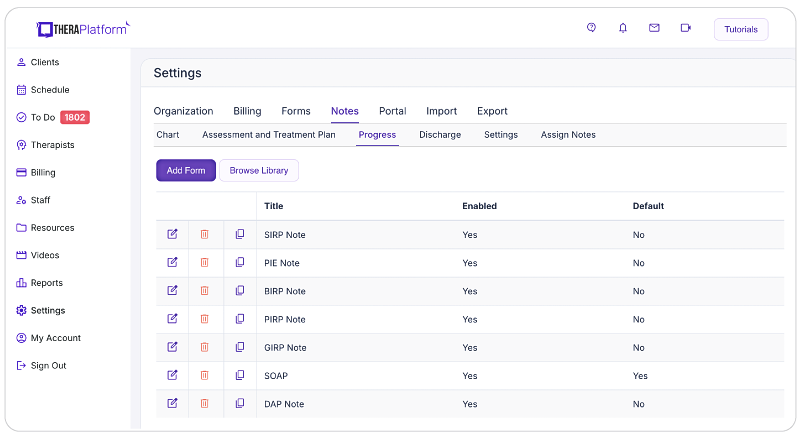
- Customizable notes: Not all EHRs offer customizable note templates tailored to therapists' unique needs. However, with a robust and user-friendly note template builder, therapists can customize note templates to align with their preferred note-taking style. This flexibility allows for efficient data entry, whether therapists prefer separating sections or using a single note field or checkboxes for mental status or techniques.

- HIPAA-compliant note storage: EHRs prioritize data security by implementing bank-level encryption to safeguard notes and other client information. TheraPlatform, for instance, ensures HIPAA compliance by offering signed, legally-binding Business Associate Agreements to protect Protected Health Information (PHI) between compliant entities.
- Seamless note sharing with clients: Clients may request access to their notes to better understand their treatment or keep them for record-keeping purposes. Using an EHR, therapists can securely share notes with clients, saving time compared to paper-based practices. TheraPlatform, a HIPAA-compliant EHR for therapists, facilitates secure note sharing with clients.
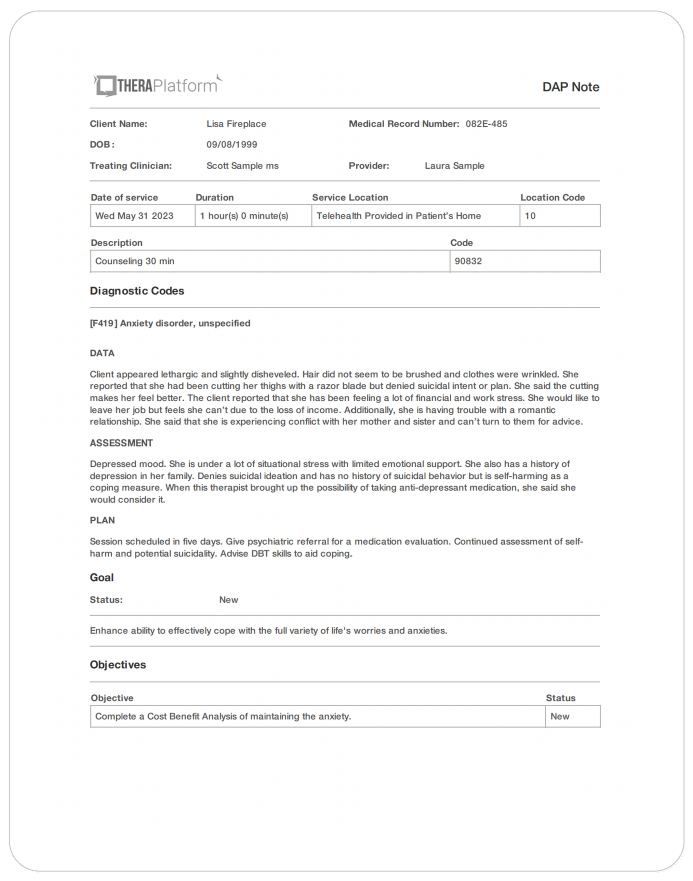
- Duplicate notes: In cases where the data remains the same across multiple sessions, duplicating notes can save time. This feature is particularly useful when clients exhibit repetitive behaviors or show minimal progress, allowing therapists to refer back to previous notes for accurate documentation.
- Client signatures made easy: EHRs streamline the process of requesting client signatures. TheraPlatform's Pro and Pro Plus plans enable therapists to request electronic signatures directly on notes. Clients can conveniently download and print the documents requiring their signatures.
- Easier faxing: TheraPlatform offers efax integration as an add-on feature, eliminating the need for toggling between multiple services. This integrated solution allows therapists to send and receive documents, including notes, via fax directly from TheraPlatform. Additionally, received faxes can be easily filed under the respective client's charts.
Additional tools and outcome measures to help with data collection and progress monitoring
Therapists can also take advantage of EHRs (such as TheraPlatform) that offer integrations with Wiley treatment planners to ensure consistent data collection on progress from session to session. The best part about partnering with a modern EHR is the time you save on formulating the actual notes and scoring.
What is Wiley Treatment Planner?
Wiley Treatment Planner is a widely used clinical resource designed to help mental health professionals and other therapists efficiently create treatment plans for their clients. In addition to treatment plans, the company also provides prewritten therapy notes for some diagnostic codes. It is part of the "PracticePlanners" series published by Wiley.
Features of Wiley Treatment Planner includes:
- Prewritten, evidence-based treatment goals, objectives, and interventions
- Treatment planners tailored to specific populations and problems, including adults, children, adolescents, couples, families, addictions, and more
- Alignment with the diagnostic criteria from the DSM-5 and ICD-10
- Prewritten therapy notes
Is there an online version of Wiley Treatment Planner and how can I get the Wiley Treatment Planner?
Wiley Treatment Planner company partnered with a select number of EHRs for mental health providers to make treatment planners available online. TheraPlatform’s EHR offers the Wiley Treatment Planner as an add-on for both assessment and treatment plans and therapy notes, such as notes. You can edit prewritten notes and add your own with any therapy template on TheraPlatform.
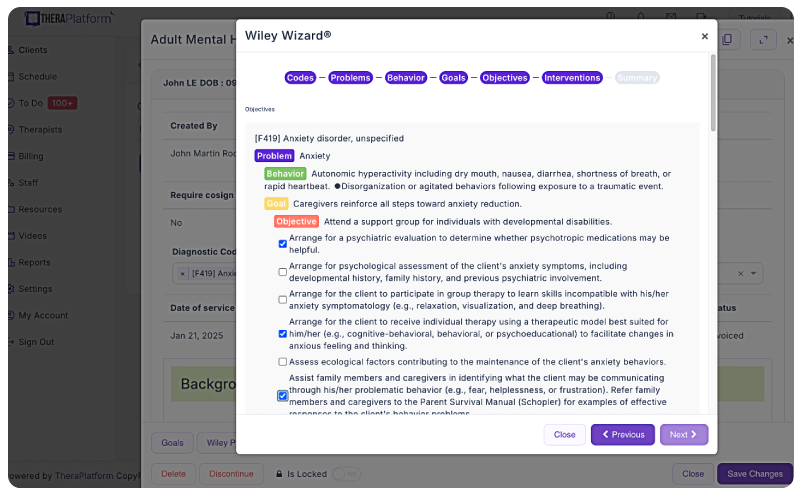
Save time with automatically scored outcome measures
Mental health therapists can use outcome measures to document progress, track a variety of key clinical indicators, helping providers make data-driven decisions, improve communication with clients, and improve client outcomes. Additionally, outcome measures help therapists adhere to compliance requirements and provide documentation needed to support reimbursement.
Watch this video to learn about how to autoscore outcome measures
→ Sign up for a Free Frial
While outcome measures clearly provide benefits to both clients and therapists, they can be time-consuming, especially if clinicians score responses manually.
However, many aspects of outcome measures can be automated through an EHR like TheraPlatform:
- Sending measurements: Common assessments such as the PHQ-9 or GAD-7 can be automatically sent to clients and stored in their records or they can be scheduled on regular intervals.
- Auto scoring: TheraPlatfrom automatically scores and sums totals for common outcome measures.
- Report building and analysis: Results can be analyzed over time, with visual charts showing progress on rates of severity and session-to-session progress.
By regularly using these measures, therapists can gain valuable insights, tailor interventions, and improve client outcomes while demonstrating the effectiveness of their care without manual entry.
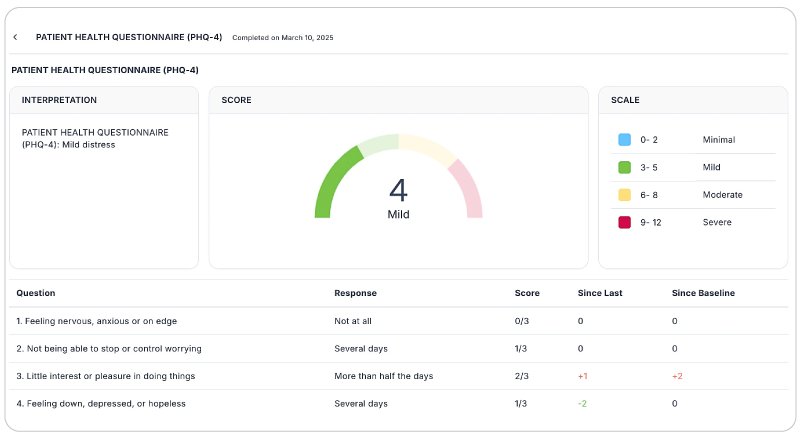
By leveraging the capabilities of EHR software like TheraPlatform, therapists can enhance the accuracy, efficiency, and accessibility of their notes, allowing them more time to enhance client care.
Streamline your practice with One EHR
- Scheduling
- Flexible notes
- Template library
- Billing & payments
- Insurance claims
- Client portal
- Telehealth
- E-fax

Resources
Theraplatform is an all-in-one EHR, practice management and teletherapy solution with AI-powered note taking features that allows you to focus more on patient care. With a 30-day free trial, you have the opportunity to experience Theraplatform for yourself with no credit card required. Cancel anytime. They also support different industries including mental and behavioral health therapists in group practices and solo practices.
More resources
- Therapy resources and worksheets
- Therapy private practice courses
- Ultimate teletherapy ebook
- The Ultimate Insurance Billing Guide for Therapists
- The Ultimate Guide to Starting a Private Therapy Practice

